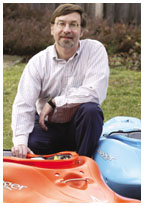Have an opinion about this issue of PAW? Please take a minute to click here and fill out our online questionnaire. It’s an easy way to let the editors know what you like and dislike, and how you think PAW might do better. (All responses will be kept anonymous.) |
March 9, 2005: A moment with...
(Photo by Frank Wojciechowski) |
Rick Curtis ’79
For the past three decades, incoming freshmen have come to campus a week before the semester begins — only to leave again on backpacking, canoeing, or rock-climbing trips with Outdoor Action. In places like Vermont’s Green Mountains and Virginia’s Appalachian Trail, the students forge friendships that ease the transition to college life. Last fall, 548 members of the Class of 2008 — about half the class — participated in OA’s 30th anniversary frosh trip. (Activities continue during the school year, when students can choose from OA’s backpacking trips during breaks, weekend day hikes, and rock-climbing and kayaking classes.) Rick Curtis ’79, director for the last 24 years, missed his own frosh trip but has been making up for it ever since. The second edition of his book, The Backpacker’s Field Manual, which started out as a spiral-bound manual for OA leaders, will be published by Random House in May. Curtis spoke with PAW’s Katherine Federici Greenwood.
How did you get involved in wilderness adventures?
I went on my first backpacking trip with my brother [Ben ’76] when I was 16. We hiked up into the high peaks in the Adirondacks. We got caught in a thunderstorm in the late afternoon and had to bivouac in the middle of this just awful ledge. We had no water. I woke up the next day sick to my stomach. I was miserable and could not wait to get back to the car. I didn’t think I would ever go backpacking again, until I came to Princeton. Freshman year, I met a bunch of OA leaders and started going on OA trips, and found that I loved it.
What do freshmen get out of Outdoor Action’s pre-orientation trips?
The incoming students have a certain amount of anxiety: Am I going to fit in? Am I as smart as everybody else? The frosh trip helps ground people. And they make friends. Some of those friendships last all four years and beyond.
There’s something unique about [an orientation experience] in a wilderness environment. I don’t think you would accomplish the same thing if you said, let’s take 10 frosh and two upperclass students and live in the dorms for a week, because there are the challenging parts of the [OA] trip. The students have to carry all their own gear, cook all their own meals, and set up their tarp at night to stay dry. If you don’t set up the tarp right and it rains in the middle of the night, everybody gets wet. So there is an immediate interdependency; that’s what helps build the strong bonds.
At the end of the trip there will be kids who say, “This was so great, I can’t wait to go on another OA trip.” There also will be kids who say, “I’m never going backpacking again, but I’m still glad that I went on this trip.” And everyone says, “I really liked the people I met. I feel much more comfortable about starting Princeton. And I’ll be able to make a place for myself.”
How do students deal with being without cell phones and showers?
It is a neutralizing experience. Everybody is in the same boat. And it really doesn’t matter what your SAT scores were. They are all dealing with the same conditions and they all have to work together.
Why is immersion in nature so important?
The life of a typical Princeton student is so pressured and hectic. On OA trips there is a much slower pace. Students go to bed when they are tired and get up when it is light out. These trips allow people to spend a lot of time talking on the trails because there is no assignment to read or paper to write. To slow down, to appreciate and notice nature — it’s very renewing for people to be in the relaxed pace of the natural world. That’s one way I re-energize.
You’ve said people experience personal growth and self-discovery on wilderness trips. What do you mean by that?
Here’s a personal example from an alumni trip we did back in 1992. We took a group trekking in Nepal and we had to hike over the Thorong La pass, right after a snowstorm. You hike from about 14,000 feet up to 17,000, then back down to 12,000, all in one day. The conditions were really challenging; it was cold and there was snow everywhere. It was the longest day of hiking I have ever done. You are hiking along and you would look up and see what looked like the top of the pass. You would trudge on for 40 minutes and get to the top of the ridge and realize that you weren’t at the top of the pass at all, and that there would be another ridge beyond that. So I’d look back down at the trail and just take one step at a time, struggling to breathe at high altitude. That went on for hours. Every once in a while I would look up to see what my next goal was, and then look back down and keep walking.
That pass has become for me a metaphor for how to deal with the challenges
of life: You look ahead periodically to spot your goal, and then you have
to just look back down and focus on taking the next step. ![]()


